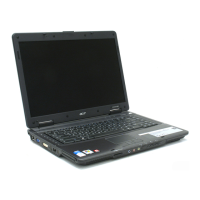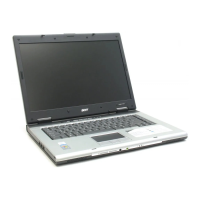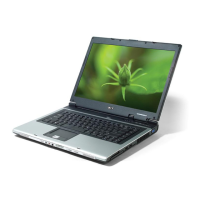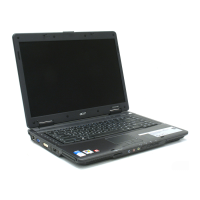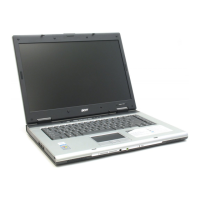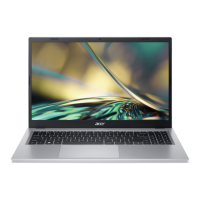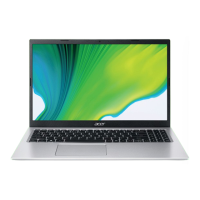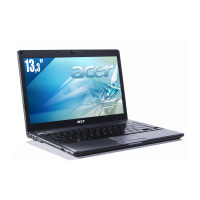



Do you have a question about the Acer Aspire 3630 and is the answer not in the manual?
Initial tips for computer care and turning it on/off.
Protecting the computer from environmental factors and physical damage.
Best practices for handling and maintaining the battery pack.
Device compliance with FCC rules and general operating conditions.
Identification and function of components on the notebook's front panel.
Identification of ports and drives on the left side.
Identification of ports and slots on the right side.
Identification of components located on the notebook's base.
Detailed explanation of the computer's status indicator lights.
Details on processor, memory, and display specifications.
Description of keyboard, touchpad, and other input devices.
Details about the International Travelers Warranty (ITW).
Functionality and default applications of the easy-launch buttons.
Introduction to Acer eManager for accessing system utilities and settings.
How to use the touchpad for cursor control and selection.
Using function key combinations and special keys like Euro/Dollar.
How to attach a physical security lock to prevent theft.
How to adjust the notebook's audio volume using buttons or hotkeys.
Introduction to Acer eManager for accessing system utilities and settings.
Using Acer GridVista for managing multiple displays.
Guide on using Norton AntiVirus for system protection and virus scanning.
Solutions to common issues like boot problems, screen display, and audio.
Guidelines for requesting service, including warranty and before-call information.
Introduction to Acer Arcade for managing media content.
Using keyboard shortcuts to control Acer Arcade functions.
How to navigate and play media files within Acer Arcade.
Adjusting display, audio, and other settings in Acer Arcade.
Playing DVD movies and VCDs using the Cinema function.
Configuring video playback options and enhancements for DVDs.
How to view individual photos and organize them in the Album feature.
Customizing slideshow duration, transition effects, and background music.
How to play video files and use the playback control panel.
Listening to music files and ripping CDs in Acer Arcade.
Features for watching TV, recording, and using instant replay.
Viewing recorded TV shows and setting up recording schedules.
Configuring TV source, country, recording quality, and audio settings.
List of supported and not supported file types for Cinema, Video, Album, and Music modes.
Steps to safely disconnect the notebook from external accessories.
Advice on what to bring and how to manage the notebook during meetings.
Guidelines to protect the computer during travel, including temperature and condensation.
Advice for international travel, including power compatibility and modem use.
Setting up Supervisor, User, and Boot passwords for system protection.
Procedures for entering existing passwords and setting new ones via BIOS.
Using the built-in modem and warnings about phone line compatibility.
Connecting to an Ethernet-based network using the RJ-45 port.
Step-by-step guide for installing or upgrading system memory.
Configuring the order in which the computer boots from various devices.
Configuring the BIOS setting for enabling disk-to-disk recovery feature.
How to play DVD movies, including region code information.
Introduction to Acer eRecovery for system backup and restoration.
Steps to create backup images of the system to HDD, CD, or DVD.
Creating a recovery CD for the factory default system image.
Guidance on identifying and resolving common system errors and symptoms.
Manufacturer's declaration of conformity with FCC Part 15 rules.
Manufacturer's declaration of conformity with EU directives for CE marking.
Notices related to modem usage, country compatibility, and TBR 21 approval.
Specific requirements for modem connection in New Zealand.
Essential safety guidelines for using and maintaining the product.
Information regarding the laser classification of the optical drive.
Compliance with radio frequency and safety standards for wireless devices.
RF exposure compliance and safety distance requirements for wireless components.
Operating conditions for low-power radio devices in Canada (RSS-210).
| Max RAM | 2 GB |
|---|---|
| Storage | 40 GB HDD |
| Graphics | Intel GMA 900 |
| Operating System | Windows XP Home |
| Weight | 2.8 kg |
| Processor | Intel Celeron M 370 |
| RAM | 256 MB DDR2 |
| Optical Drive | DVD/CD-RW combo |
| Networking | 10/100 Ethernet, 802.11b/g WLAN |
| Ports | 3x USB 2.0, VGA, Ethernet, Modem, Audio in/out |
| Battery | 6-cell Li-Ion |
